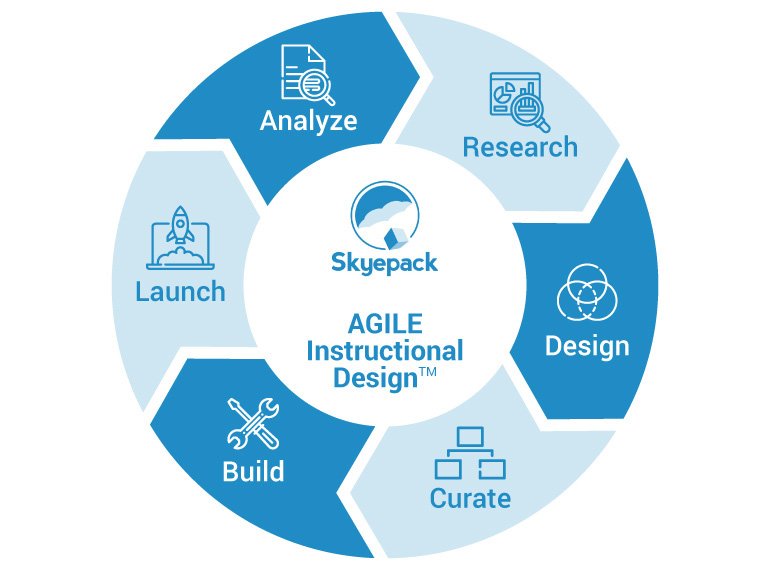
As a nonprofit professional, you’re constantly on the lookout for new ways to maximize your fundraising capacity and make a bigger impact on your mission. One way to boost your potential is to offer continuing education and training opportunities to your volunteers, staff, and board members.
Trainings should include initial onboarding sessions when an individual first becomes involved with your organization, as well as ongoing development opportunities. Historically, you may have had in-person training sessions and introductory activities to bring new team members up to speed, but now this process likely occurs digitally.
As you refine your virtual training process for the rest of 2021, consider whether your current approach is satisfying your nonprofit’s needs. An effective virtual training program should inform and empower all stakeholders at your organization to drive your work forward.
At Skyepack, we curate and build digital course materials for a variety of organizations. We’ve compiled this guide to help your nonprofit develop effective training materials that you’ll use for years to come. We’ll cover the following topics:
- Key Considerations for Virtual Training Materials
- Process for Creating Training Materials
- Common Types of Nonprofit Training Materials
- 4 Best Practices for Training
With the right tools and content, your virtual training materials will be even more useful than an in-person program—after all, trainees appreciate online content for its mobile accessibility and convenience. Even once you resume in-person activities, your virtual training program may be here to stay.
Key Considerations for Virtual Training Materials
Before you explore the nitty-gritty of developing training content, it’s wise to address a few big-picture topics that will guide your efforts.
To design a volunteer or staff training program that aligns with your goals, you need to start with an accurate understanding of those goals—specifically, why and for whom is the training program being developed? Think through the following topics:
Audience. Who will be completing this course? Think about what background information they’re coming in with, and what they’ll need to know upon completion of the program. This will differ depending on your organization and the function of each group. Later in this article, we’ll walk through a few of the most common audiences for a nonprofit training program. You’ll also want to consider the general tech-savviness of your audience before choosing a content delivery platform. Typically, you’ll want to choose a solution that is intuitive and user-friendly while still including all the essential features.
Purpose. Consider the desired outcome of the training program. Are you trying to transfer organizational knowledge, increase proficiency in a specific software solution, or develop soft skills? Are these onboarding materials or part of a continuing education program? Before curating your course’s content, you should have at least a rough idea of what you want to cover.
All educational materials—whether they’re for a college classroom or nonprofit boardroom—will be more engaging and powerful when they’re designed for the unique needs of the audience. . Analyzing the audience and purpose of your training materials before getting started is a worthy investment of time and energy.
Process for Creating Training Materials
Once you’ve outlined the objectives of your training program, you can begin the process of developing the course materials. While this process can very significantly from organization to organization, it should include stages that analyze the needs of your audience.
For example, let’s take a look at Skyepack’s curriculum development process, which follows six key steps.

As you can see, this process is cyclical rather than linear, because your course should adapt and evolve over time as your needs change. Here’s how each step works:
Analyze. In this phase, you assess the objectives of the program, paying close attention to the audience and the purpose as discussed earlier in this article. You’ll also want to take stock of any existing training program, including what’s working well and what has room for improvement.
Research. Next, research available learning materials based on your current training program and evaluate any potential areas of improvement. Now is the time to identify new topic areas to cover.
Design. Determine the layout and flow of your course. In what order should the topics be presented for maximum impact? In any case, it’s helpful to start with a brief history of your organization and build from there.
Curate. Select the most useful resources from your past training material and free training resources, and identify any areas where you’ll need to develop new content. A professional instructional designer can help you weed through the vast amount of training material available to unearth the best content that fits your needs.
Build. Based on your research, curated resources, and understanding of your team, it’s time to put the course together. Be sure to choose a content delivery platform that can easily be edited as time goes on.
Launch. Share your new training program with your volunteers, board members, or staff. On launch day, be sure you have a plan for any technical difficulties or access issues that may arise.
Analyze again. Collect qualitative and quantitative feedback from individuals who take the course, then use this information to make improvements.
This course design process is based on Agile methodology, a framework originally created for software development that focuses on continuous improvement over time. While there are many approaches you could take to design your training program, be sure to choose a process that focuses on providing value for the learners.
Common Types of Nonprofit Training Materials
Board Members
Board member onboarding is critical for the long-term engagement of new members. If someone starts off feeling confused, overwhelmed, or out of the loop, it will be challenging to participate fully in the conversation.
By starting with a virtual training program for your board members, you can equip and empower them to maximize their involvement, time, and contribution of skills.
Boardable’s guide to welcoming new board members recommends including ample information about your nonprofit’s history, financial situation, and individual responsibilities to set each individual up for success.
Volunteers
A new volunteer may not need quite as much background about your organizational history as a board member, but they should still understand your mission and work.
As this guide to volunteer training suggests, investing in this kind of program can lead to long-term benefits for volunteer engagement, retention, and efficiency.
As you develop your virtual volunteer training materials, think critically about the tasks volunteers will be asked to complete, and how you can prepare them most effectively. It may be helpful to seek advice from long-time volunteers, asking, “What would have been helpful for you to know when you first started?” Surveying volunteers is a general best practice for volunteer management, but it’s particularly helpful for training. Over time, you can develop a volunteer training program that empowers volunteers to make a more substantial impact on your mission.
Staff
As you build your development department or hire other staff members, you’ll need to bring these new employees up to speed as quickly as possible. By preparing a comprehensive virtual onboarding curriculum ahead of time, you’ll have a consistent way to bring new employees into the fold. Of course, adaptations will need to be made for each role, but you can still create training materials that could start any staff member off on the right foot.
Don’t forget to offer ongoing training opportunities as well. Continuing education programs can help you boost employee satisfaction (and retention) as well as improve organizational productivity and efficacy.
4 Best Practices for Training
Your virtual training materials are a key component for the success of your board members, volunteers, and employees.
By following the steps outlined above, you’ll have a good framework to start preparing your virtual training materials. As you navigate the process, here are a few additional best practices to keep in mind:
Prioritize the trainee. Throughout each step of the planning process, keep the needs of your trainees at front-of-mind. Each decision you make should be tailored towards equipping them with the right set of skills and knowledge.
Seek expertise where necessary. If you’re starting your training program from scratch or integrating highly complex material, you may need to bring in some outside help. This may include referencing a subject-matter expert, adding technology tutorials for your nonprofit software, or partnering with an instructional design service to curate high-quality training materials.
Content first, technology second. While it may be tempting to jump on the latest and greatest instructional design innovations, don’t let these trends cloud your perspective on what will be most valuable for trainees.
Make improvements over time. Developing your virtual training program shouldn’t be a one-and-done task. As each cohort of trainees completes the process, seek feedback on how it could be improved. Use the course development cycle to refine your training materials over time.
In addition to these considerations for any training program, you’ll also want to keep in mind any virtual-specific needs. For instance, with an online-only course, how will trainees ask questions or seek clarification? Will there be a venue for peers to collaborate and discuss key topics? Be sure to address these issues ahead of your course’s launch.
Even in the virtual era, your nonprofit must provide useful training materials to get volunteers, board members, and staff up and running. To start the course development process, focus on analyzing the needs of your trainees and your organization. An instructional design expert can help you ask the right questions and create a course that is both engaging and effective.
____________________________________
Guest Post by Brady Kalb, CEO, Skyepack
Brady is a "reformed engineer turned entrepreneur". After engineering gigs at two Fortune 100 companies, Brady left the corporate world to pursue a business degree and seek out new challenges. Brady's passion for education stems from his desire to "always be learning" and find innovative solutions to difficult problems. Brady enjoys family outings to the park, explaining the answers of "Life, the Universe, and Everything" to his daughters, and reading just about anything (favorites are classics, popular fiction, and biographies).